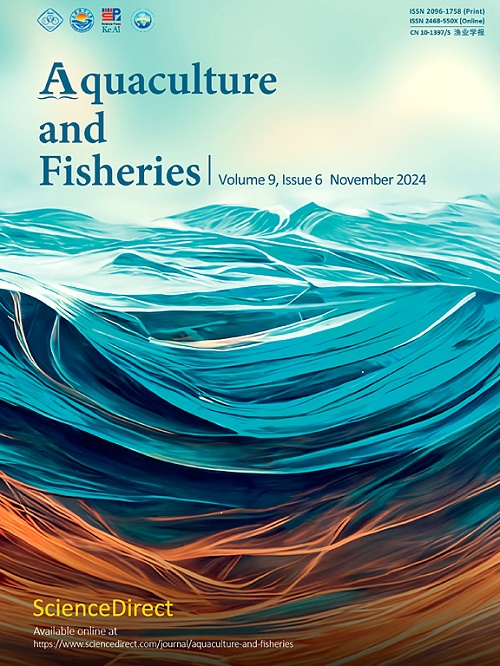Polymorphisms in cathepsin b is associated with growth in Asian seabass
Q1 Agricultural and Biological Sciences
引用次数: 0
Abstract
This study investigates the relationship between polymorphisms in the cathepsin B (ctsb) gene and body weight in Asian seabass (Lates calcarifer). Despite the economic significance of this species, the genetic factors that influence growth performance in fish remain poorly understood. CTSB, a lysosomal cysteine protease involved in protein degradation and tissue remodelling, is a crucial regulator of growth. We analysed the full-length cDNA of ctsb and mapped it to the major quantitative trait locus (QTL) for growth on linkage group 2 in L. calcarifer. Single nucleotide polymorphisms (SNPs) within ctsb were identified and their associations with body weight were analysed in 298 individuals. Results revealed that SNP1 (C > T) in intron 2 of ctsb was significantly correlated with body weight. Quantitative real-time PCR (qRT-PCR) showed that ctsb was expressed in all tissues, with the highest expression in the gills and kidney of developing seabass. Knockdown/overexpression of ctsb in cell lines respectively promoted/inhibited cell proliferation without altering cell size. These findings suggest that ctsb plays a significant role in growth regulation in Asian seabass. This study provides a potential molecular marker for selecting fast-growing Asian seabass. Future research should focus on identifying causal variants in ctsb associated with accelerated growth, conducting in vivo studies, and exploring related signalling pathways.
组织蛋白酶b的多态性与亚洲鲈鱼的生长有关
本研究探讨了亚洲海鲈组织蛋白酶B (ctsb)基因多态性与体重的关系。尽管这一物种具有重要的经济意义,但影响鱼类生长性能的遗传因素仍然知之甚少。CTSB是一种参与蛋白质降解和组织重塑的溶酶体半胱氨酸蛋白酶,是一种重要的生长调节剂。我们分析了ctsb的全长cDNA,并将其定位到钙化L.连锁群2上生长的主要数量性状位点(QTL)。在298例个体中鉴定了ctsb内的单核苷酸多态性(snp),并分析了其与体重的关系。结果显示,ctsb内含子2中的SNP1 (C >; T)与体重显著相关。实时荧光定量PCR (Quantitative real-time PCR, qRT-PCR)结果显示,ctsb在发育中的鲈鱼各组织中均有表达,其中鳃和肾表达量最高。ctsb在细胞系中敲低/过表达分别促进/抑制细胞增殖,但不改变细胞大小。这些结果表明,ctsb在亚洲鲈鱼的生长调节中起着重要作用。该研究为快速生长的亚洲海鱼的筛选提供了潜在的分子标记。未来的研究应侧重于识别与ctsb加速生长相关的因果变异,进行体内研究,并探索相关的信号通路。
本文章由计算机程序翻译,如有差异,请以英文原文为准。
求助全文
约1分钟内获得全文
求助全文
来源期刊

Aquaculture and Fisheries
Agricultural and Biological Sciences-Aquatic Science
CiteScore
7.50
自引率
0.00%
发文量
54
审稿时长
48 days
期刊介绍:
 求助内容:
求助内容: 应助结果提醒方式:
应助结果提醒方式:


